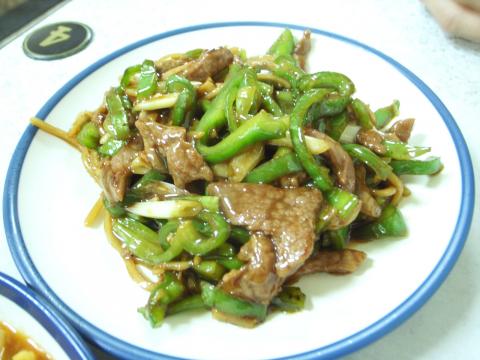Nothing brings a neighborhood together like good, inexpensive food. Heyuan (和園), a Sichuan eatery near the Executive Yuan on Zhongxiao East Road (忠孝東路), attracts a lunchtime crowd made up of government employees, taxi drivers, business types, students and retirees.
It’s probably the old red sign reading “economically priced Sichuan dishes” (川味經濟小吃) that lures in first-time patrons. They certainly don’t come for the atmosphere: Heyuan is an aging hole-in-the-wall, dimly lit with fluorescent lights.
But the tasty, family-style grub keeps the room full during mealtimes. Stir-fry dishes, averaging NT$100, make up most of the menu, with the constant clacking of spatulas and woks to prove it.

Photo: David Chen, Taipei Times
Diners choose from a long list of dishes full of Sichuan standards like kung pao chicken (宮保雞丁, NT$120) or spicy stir-fried eggplant (魚香茄子, NT$90).
Heyuan’s mapo tofu (麻婆豆腐, NT$60) is a good example of the restaurant’s home-cooked goodness: the gravy-like sauce, full of chilis, scallions, ginger and garlic, has a zesty, spicy kick, but won’t leave you crying into your rice bowl.
Egg dishes seem to be a popular choice, judging from a peek at our neighboring tables. Choices include the traditional Taiwanese oyster omelet (蚵仔烘蛋, NT$80) and omelet with pickled radish (菜脯蛋, NT$60).
We stuck with the Sichuan theme and had the spicy yuxiang hongdan (魚香烘蛋, NT$90), literally “fish flavor omelet,” which actually has no fish it, but rather minced pork. (The name refers to a spicy sauce commonly used in Sichuan cooking to garnish fish.) This dish was good, but the flavor was too similar to the mapo tofu. Order one or the other.
Balance the spicy dishes with qingjiao niurou, or stir-fried beef with green peppers (青椒牛肉, NT$110). The beef is tender and garnished with scallions and ginger in a sweet glaze sauce.
Despite the greasy spoon vibe, Heyuan is clean and well kept. The Formica tables and plastic chairs look like they get a regular scrubbing and the floors don’t have that mysterious stickiness sometimes found at lunch shops. The waitstaff is very friendly and pleasant, and the shop offers complimentary spring water and chrysanthemum tea.
Heyuan is more enjoyable with a companion or two, but if dining alone, plate meals or a biandang (便當) can be had for NT$80, and there is a long list of fried rice and stewed dishes with rice from NT$65 to NT$90. The gaolicai chaofan (高麗菜炒飯, NT$65), or fried rice with egg and cabbage, is good value for a quick and satisfying meal. Or choose a single dish from the list of stir-fry selections and have it with a bowl of rice (NT$10), which comes in a generous portion. The ganbian sijidou, stir-fried green beans (乾扁四季豆, NT$100), is a bit greasy, but a decent take on a Sichuan classic.
Another reason why Heyuan probably does a brisk business is that there are few restaurants in the neighborhood serving family-style cuisine. The place felt like a godsend after a recent visit to Huashan 1914 Creative Park (華山1914). If you’re not in the mood for this stretch of Zhongxiao East Road’s sparse selection of 7-Elevens, fast-food chains and overpriced restaurants, it’s a good place to keep in mind.

Exceptions to the rule are sometimes revealing. For a brief few years, there was an emerging ideological split between the Democratic Progressive Party (DPP) and Chinese Nationalist Party (KMT) that appeared to be pushing the DPP in a direction that would be considered more liberal, and the KMT more conservative. In the previous column, “The KMT-DPP’s bureaucrat-led developmental state” (Dec. 11, page 12), we examined how Taiwan’s democratic system developed, and how both the two main parties largely accepted a similar consensus on how Taiwan should be run domestically and did not split along the left-right lines more familiar in

As I finally slid into the warm embrace of the hot, clifftop pool, it was a serene moment of reflection. The sound of the river reflected off the cave walls, the white of our camping lights reflected off the dark, shimmering surface of the water, and I reflected on how fortunate I was to be here. After all, the beautiful walk through narrow canyons that had brought us here had been inaccessible for five years — and will be again soon. The day had started at the Huisun Forest Area (惠蓀林場), at the end of Nantou County Route 80, north and east

Specialty sandwiches loaded with the contents of an entire charcuterie board, overflowing with sauces, creams and all manner of creative add-ons, is perhaps one of the biggest global food trends of this year. From London to New York, lines form down the block for mortadella, burrata, pistachio and more stuffed between slices of fresh sourdough, rye or focaccia. To try the trend in Taipei, Munchies Mafia is for sure the spot — could this be the best sandwich in town? Carlos from Spain and Sergio from Mexico opened this spot just seven months ago. The two met working in the

This month the government ordered a one-year block of Xiaohongshu (小紅書) or Rednote, a Chinese social media platform with more than 3 million users in Taiwan. The government pointed to widespread fraud activity on the platform, along with cybersecurity failures. Officials said that they had reached out to the company and asked it to change. However, they received no response. The pro-China parties, the Chinese Nationalist Party (KMT) and Taiwan People’s Party (TPP), immediately swung into action, denouncing the ban as an attack on free speech. This “free speech” claim was then echoed by the People’s Republic of China (PRC),